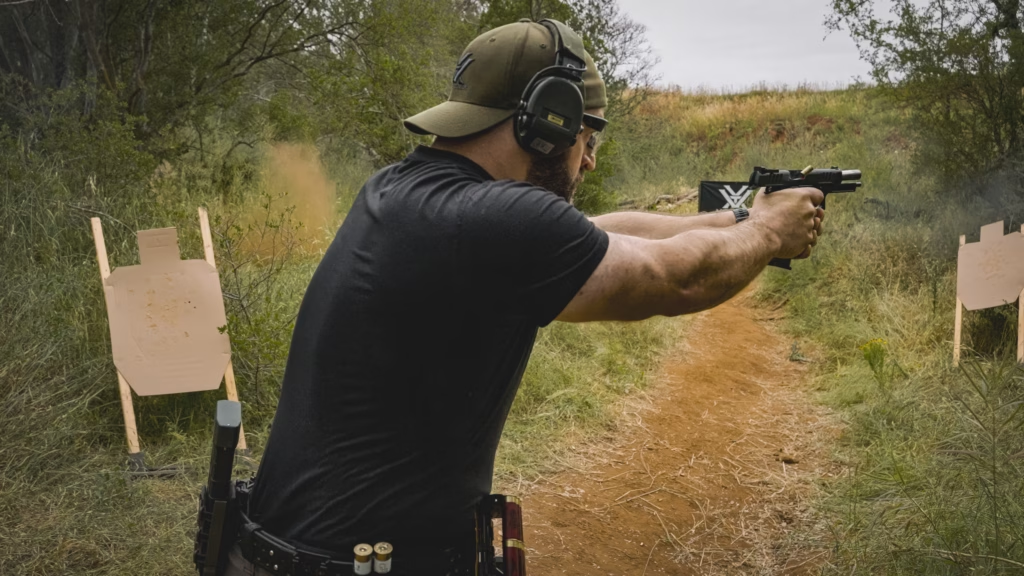Among the many safety rules in competition shooting, the 180 degree rule is a critical guideline designed to maintain a safe environment for shooters, spectators, and range officials. This article covers the importance of the Rule of 180, its implications in various shooting sports, and how competitors can internalize and abide by this rule to ensure safety and success in competition.

The Rule of 180 is a fundamental safety principle in competitive shooting that dictates the orientation of a shooter’s firearm relative to a 180-degree imaginary line parallel to the firing line. This rule is designed to prevent accidental discharges in unsafe directions. The muzzle of the gun must always point downrange, within the 180-degree arc. This means no pointing the gun up, down, or back towards the shooter or spectators, which would constitute breaking the 180-degree plane.
Safety: The primary purpose of this rule is to ensure the safety of everyone at the event. By restricting the direction in which a gun can be pointed, the risk of accidental injury from an unintended discharge is greatly reduced.
Fair Play: The Rule of 180 also ensures a level playing field. It applies equally to all competitors, emphasizing the importance of gun handling skills alongside shooting accuracy and speed.
Penalties for Breaking the Rule: In all competitions, violating the Rule of 180 results in immediate match disqualification (DQ). This strict enforcement underscores the rule’s importance and ensures all competitors take it seriously.
Practical Shooting (IPSC/USPSA): These disciplines involve moving through various courses of fire where shooters engage targets at different angles. The dynamic nature of these sports makes adherence to the Rule of 180 especially crucial.
3-Gun or Multigun: In this discipline, competitors use rifles, shotguns, or pistols in various stages. The transition between firearms and varied shooting positions adds complexity to maintaining the 180-degree rule. Depending on the terrain available, you may also encounter stages with “floating 180’s” that follow the shooter through the course of fire, the Range Officers will provide specific instruction in these cases.
Precision Rifle: Although these events often involve less movement than practical shooting or 3-gun, the Rule of 180 is still strictly enforced, particularly when repositioning between shots or navigating obstacles.
The Tactical Games: In this discipline, competitors will find themselves in a heat with four other athletes in a line. The 180-degree rule must be followed for everyone’s safety on the line.
Mindfulness and Muscle Memory: Constant awareness of your muzzle direction is important. Regular dry-fire practice and handling drills at home can help develop the muscle memory needed to maintain muzzle discipline.
Train Your Finger Placement: Getting your finger off the trigger and up against the receiver when getting ready to move will put it parallel with the barrel direction. We have an astute awareness with what our finger is pointing at without having to look at it, making this an easy training point to drive home.
Stage Planning: Before running a stage, walk through it multiple times, planning your movements and identifying potential risk points for breaking the 180-degree rule. “Finger-gunning” a stage during your walkthrough helps you determine any positions that you need to place extra emphasis on.
Seeking Feedback and Validation: During practice sessions, have a training partner or coach watch your muzzle orientation and provide feedback. Recording the session on your phone also works, but understand that camera angles can sometimes be misleading. This external perspective can be invaluable in correcting bad habits.
Simulation and Scenario-Based Training: Engage in training that simulates match conditions, including movement, target engagement, reloading, and transitions between firearms. Again, seeking external validation for what you feel versus what’s actually happening with your muzzle can be very different in reality.
Rapid Movements: Quick turns or moving to a new shooting position can inadvertently cause the muzzle to sweep beyond the 180-degree line.
Gun Malfunctions: Clearing a jam or malfunction under pressure can lead to momentary lapses in muzzle awareness.
Reloads: Especially with pistols, it’s common for the shooter to present the firearm across their body for better magazine alignment – depending on your positioning in the stage, you might be on or over the 180 line with your muzzle.
Transitions Between Firearms: When switching from one gun to another, particularly under time pressure, it’s easy to momentarily forget about muzzle orientation.
Retrieving Dropped Magazines: Bending over or reaching for a magazine can inadvertently cause the muzzle to point in an unsafe direction.
Retreat Stages: In some cases, the stage design has you deliberately starting at a forward most position to where you need to retreat to the rear, making movement at speed while maintaining proper muzzle direction a real challenge.
Mental Rehearsal: Visualize your movements and gun handling before you shoot. This mental walkthrough can help reinforce safe practices.
Stress Management: Learn to manage adrenaline and stress, which can affect decision-making and physical control during a course of fire.
Focusing on Process Over Outcome: Concentrate on executing each step of the stage correctly, rather than rushing to achieve the fastest time.
Holsters and Slings: Use equipment that allows for safe and secure carrying of firearms, reducing the risk of unintentional muzzle movements.
Rail Accessories: Be cautious of modifications that could affect your handling of the firearm, potentially impacting muzzle discipline. Rail accessories can be a major burden in navigating and getting caught up on shooting barricades, causing you to be ahead of where you expected your muzzle to be.
Range officers play a crucial role in enforcing the Rule of 180. They observe shooters during stages to ensure compliance and intervene if the rule is broken. Their presence adds an extra layer of safety, but the accountability ultimately falls on the shooter.
Mastering the Rule of 180 is not just about following a regulation; it’s about embedding a culture of safety in competitive shooting. It requires consistent practice, mindfulness, and a deep understanding of the rule’s importance.
Whether you’re a new shooter or an experienced competitor, respecting the Rule of 180 is non-negotiable. In short – don’t be an asshole, know where your muzzle is pointed at all times and don’t push beyond your capabilities to navigate a stage safely.
